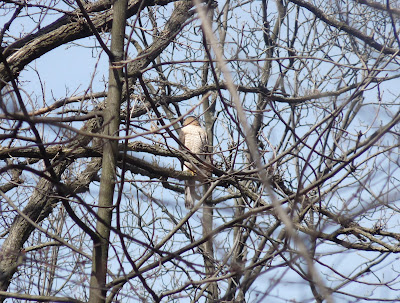I haven't gotten into butterfly id (yet), but if it lands in my garden, I will try to look it up. Life has slowed, somewhat, since we returned home and I have been able to spend a bit of time out in our yard.
Perhaps the extra rain convinced some birds that it was springtime. We came home 2 weeks ago to find a baby mourning dove sitting in a nest that was built (and never used) by robins months ago!
House sparrows must have nested nearby as well, likely in the yard somewhere, as we have tons of them around. Today I was watching an adult feed babies in the garden. It always surprises me how fast the chicks grow - sometimes they seem larger than the adult!
The previous owners planted a butterfly bush in the yard - and it really does attract butterflies! Yesterday, I noticed some activity and went out to find this Eastern Tiger Swallowtail.
 |
| Eastern Tiger Swallowtail |
Nearby, a monarch was feeding.
 |
| Monarch |
A large insect buzzed past me and onto the butterfly bush. A hummingbird moth!
 |
| Hummingbird Moth |
Today, at about the same time in the evening, I looked out and again noticed some activity around the butterfly bush. A Black Swallowtail was busy feeding.
 |
| Black Swallowtail |
Also flitting around was this Sliver Spotted Skipper. I am trying to learn these butterflies by photographing them, so it's not the greatest pic, but it did the trick (unless I'm wrong...).
 | |
| Silver Spotted Skipper |
My book1 says this butterfly is around from early June to late July and here we are at the end of August. I wonder if this is an extra generation given the early spring that we had this year... Or maybe it is common to see them in late August. I don't know - I'm new to this!
Meanwhile, a Red Admiral was busy over on the Mexican hat plant (I have no idea if that is the real name of this plant - it was a gift from my Mom). I remember seeing hundreds of these in the spring while we were birding at Point Pelee.
 |
| Red Admiral |
Lastly, here are 2 small butterflies that I needed some help to identify. Thanks to Jeremy and Sarah for their timely assistance! Sitting on my Joe Pye Weed is a Least Skipper.
 |
| Least Skipper |
Both yesterday and today, as I was photographing these butterflies, a Ruby Throated Hummingbird flew right by me to use our feeder! I stood in shock and watched this amazing bird hover and feed. We have been seeing hummingbirds at our feeder for several evenings now and it's always exciting! Kory tells me they are territorial and we have seen one bird chase another away. I think we need another feeder! Today, the bird was making some sounds as it flew around, sort of a short, squeaky chip!
 |
| Ruby Throated Hummingbird |
1. Carmichael, I., Vance, A. (2003). Photo field guide to the butterflies of southern Ontario. Ontario. St. Thomas Field Naturalist Club Incorporated










































